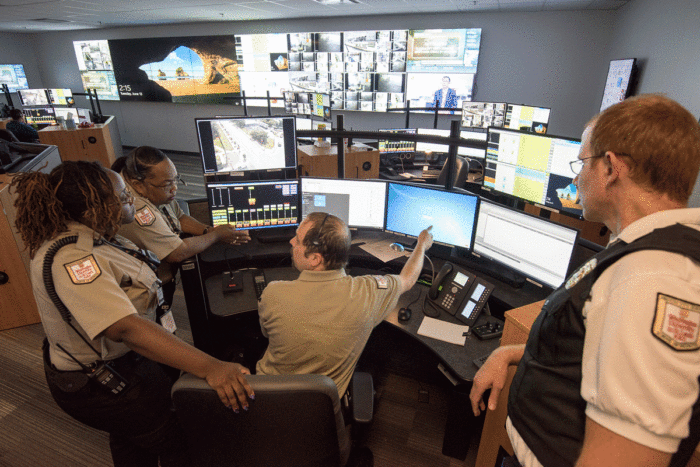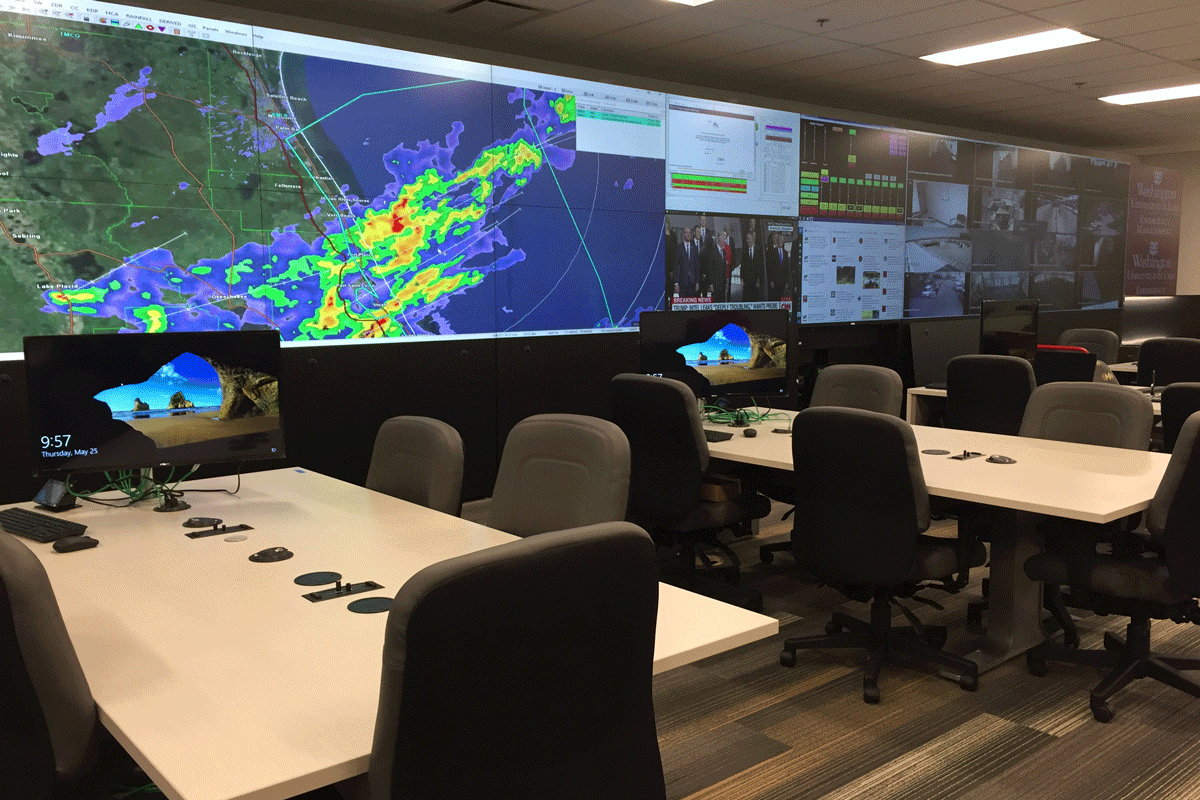Medical school and hospital align security services
Integration provides rapid, coordinated response for emergencies
 Robert Boston
Robert BostonWashington University School of Medicine communications officers (from left) Nicole Ware, Patricia Johnson and Alex Meyer, and security supervisor Andy Richards discuss campus security in the dispatch room in the Joint Public Safety Center at the Medical Campus' Mid Campus Center.
Should an emergency occur on the Washington University Medical Campus — natural or otherwise — a new, state-of-the-art Joint Public Safety Center has positioned campus security personnel to be ready for it.
Housed on the first floor of the recently opened Mid Campus Center, the space brings together the security forces of Washington University School of Medicine and Barnes-Jewish Hospital (BJH) in one location to provide a rapid, coordinated response to safety threats and other emergencies.
Similarly, the collaboration allows for security forces to act more quickly when confronted with daily disruptions on the Medical Campus.
“The vision for the Joint Public Safety Center was to align the medical school and hospital to enhance campus safety and share resources, resulting in improved responses to all campus needs on a daily basis and as emergencies arise,” said Melissa Hopkins, assistant vice chancellor and assistant dean for Operations and Facilities Management at the School of Medicine. “The new center is a major accomplishment for the two institutions and for the Medical Campus as a whole. We are constantly evaluating ways to enhance security on the Medical Campus, and bringing the two security teams together in a single space made a lot of sense.”
Altogether, the center unifies more than 200 officers, dispatchers and other staff from both institutions who are trained to respond to severe weather and natural disasters such as tornadoes, earthquakes, pandemics, civil unrest, terrorist threats and any criminal activities that could impact the campus.
The Emergency Management Department is hosting its first annual “Ready Week” Sept. 10-15. It will feature interactive events designed to engage the campus community and promote emergency preparedness. More information can be found at https://emergency.wustl.edu/ready-week/
Additionally, the School of Medicine, along with BJH, has invested $10 million in new security technology that aligns the school’s radio communications, closed-circuit television cameras and other equipment with that at BJH and St. Louis Children’s Hospital (SLCH). While SLCH maintains its own team of security officers – who work in cooperation with the medical school and BJH – the technology upgrade means that communications and technology systems are shared across the Medical Campus, helping to improve responses to emergency situations.
One feature of the new center is a designated area for School of Medicine and BJH dispatchers. In addition to updated communications systems, the dispatchers also have access to news, weather and Twitter feeds from media and local public safety agencies, which can be viewed at all times on large wall monitors. Radio communications, fire alarm systems and footage from hundreds of closed-circuit TV cameras on the Medical Campus are monitored, providing continuous information.
Another benefit is employees, students and visitors may call a single emergency number: 314-362-0911.
“We believe that treating the Medical Campus as one entity will help us to respond more quickly and in a more coordinated fashion,” said John Ursch, the School of Medicine’s executive director of Protective Services.
“Providing a quick and seamless response and ensuring the safety of all people on campus is extremely important to us, and we are always reviewing how best to achieve that.”
It was a fortunate circumstance that the Mid Campus Center was being planned at the same time as the Joint Public Safety Center, Ursch said. “It’s exciting to come to work every day in this new facility that we dreamed of and to see how the university and the hospital are working together to improve the safety of our faculty, staff, students and patients,” he said.
Despite the center’s cutting-edge technology, a yellow legal pad has served as a trusty planning tool for Ursch and his colleagues, including Ty Davisson, director of emergency management for Washington University. Four years ago, they began sketching plans for an Emergency Operations Center (EOC) within the Joint Public Safety Center to serve as a central command for coordinating responses to a large-scale emergency such as a tornado.
A pencil sketch on an 8 ½ inch-by-11 ¾ -piece of paper transformed into the EOC’s 50 foot-by-5 ½-foot video wall. The massive screen simultaneously can show multiple displays — even 100 screens, if desired — of weather maps, security-camera feeds, local and national news and other images helpful in a crisis.
“It was exciting to make sketches that laid a foundation for what would become the EOC,” said Davisson, who worked in Joplin after the 2011 tornado, coordinating emergency resources such as generators and search-and-rescue teams. “To see it all become a reality is amazing. The university’s commitment to this project and the safety of students, employees and visitors has been, and continues to be, tremendous.”
Besides the dynamic video wall, the EOC brings together experts trained in emergency response, such as security officers, key administrators and communications staff, who can work in teams to gather and exchange critical information and make decisions quickly. The EOC’s high-tech workspace can accommodate up to 75 people, with designated work stations in a shared space that allow teams to work side by side, keeping lines of communication open — critical in fast-moving situations.
“In past situations, my BJH counterpart and I would have to call each other every 10 minutes for updates,” Davisson said. “But now, when a crisis emerges, we can work side by side, which is much more efficient. If a tornado were to hit the Medical Campus, for example, the information gathered in this center would heighten our situational awareness and give us the ability to make effective operational decisions.”
The center is designed for flexibility and longevity to meet ongoing and future safety needs, Ursch added. “The physical space is impressive, but most importantly, it provides an overall framework that allows for shared communications and fire alarm systems, computer and video databases and other resources aimed at enhancing public safety,” he said.
“Over the years, for instance, BJH has developed a robust bike patrol that has served as the eyes and ears of the Medical Campus,” Ursch said. “The School of Medicine does not need its own bike patrol. Similarly, we have officers who are certified emergency medical technicians (EMTs) and it doesn’t matter if the sick or hurt person works for the university or the hospital or neither one — we’re going to help. Recently, School of Medicine Response Officers were able to help a nurse from BJH who was on campus when he suffered from a heart attack.”
Officers in the Joint Public Safety Center also responded to a more high-profile incident involving a recent carjacking in the Duncan-Central parking structure. The employee immediately used a blue-light emergency phone in the garage to report the crime and offer a detailed description of the carjacker and the vehicle, according to Michael Lauer, director of public safety for BJH.
Within moments, BJH bike patrol officers arrived at the scene, called for backup and waited at the exit for the stolen vehicle to appear. When it came speeding out of the garage, the driver saw the armed officer and ended up crashing the car into a light post, Lauer said. Although the suspect escaped, the video of the incident, the victim’s description of the assailant, and evidence at the scene is key for the St. Louis Metropolitan Police Department, which has taken over the case.
“The coordination and cooperation between our public safety teams and the many tools we now have aimed at keeping our employees, patients and others safe are making a difference,” Lauer said.
 Jacquelyn Stearns
Jacquelyn Stearns






